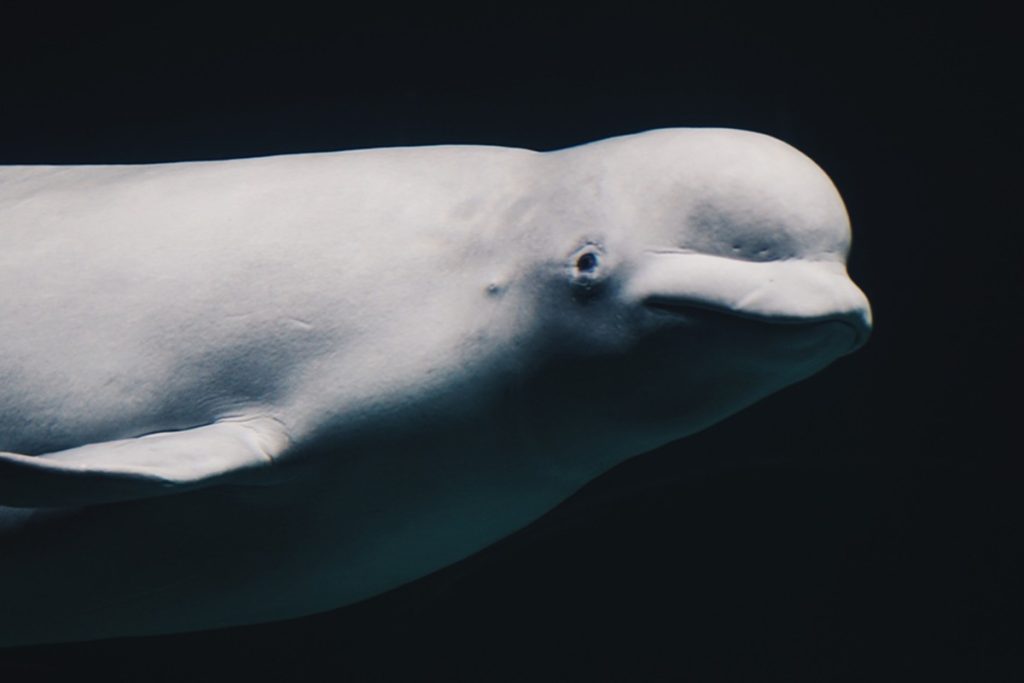Whales are not picky where they live and can be found in all of the five oceans. This also includes the Arctic region due to their thick blubber. However, of the 17 whale species found in the Arctic, only 3 remain there year-round; Bowheads, Narwhals and Belugas. Other whale species migrate to breeding grounds in warmer waters along the equator and return to the Arctic in early spring. Do you wonder what these whales eat? Read on to find out more.
There are 2 whale classifications: baleen and toothed.
Baleen whales include bowheads and humpbacks. Instead of teeth, the upper and lower jaws are lined with baleen plates, like the bristles of a brush. When whales will take in a mouthful of sea water, the baleen plates act like a filter, trapping plankton in the bristles while the water is forced back out by the whale’s tongue.
Baleen whales have two blowholes and tend to be slow, swimmers. They do not need to exert additional energy to find or catch their food. In contrast, toothed whales are hunters and are much more agile. They have a single blowhole for breathing.
Belugas and narwhals are both toothed whales, using their teeth to catch fish and crustaceans. Toothed whales do not chew their prey, they simply swallow their catch whole.
Beluga
Often called white whales or canaries of the sea, Belugas are beautiful animals with a bright white skin and a large bulge extending from their snout up to their forehead. Beluga whales live in the Arctic year-round, so what do they eat? During the winter months especially, food is harder to find.
Beluga whales have a particular taste for herring, cod and salmon, but they will also eat other fish. Crustaceans are also a staple in a Beluga’s diet. This means crab, squid and shrimp are also on the menu.
Fun Fact: Belugas can turn their heads in any direction as their neck vertebrae are not fused.
Belugas are social creatures, travelling in large pods. Males travel together and females travel with calves in separate pods. They have a wide variety of vocalisations, including whistles, clicks and clangs. This is why they are nicknamed ‘canaries of the sea’.
The biggest threats to Belugas are predators such as Polar bears and Orcas, hunting by fishermen and capture by aquatic parks for entertainment.

Narwhal
Narwhals are among the most unusual looking animals on the planet. Affectionately named ‘unicorns of the sea’, these fantastical creatures are the only horned whales alive today. It is typically only males that grow tusks, but a small percentage of females also have them.
A narwhal tusk is actually a tooth, formed in a tight spiral and growing almost 3 meters long. Scientists believe the tusk is used to impress females during courtship and to display dominance over other males.
So, what does a narwhal eat? Being a toothed whale, narwhals catch their prey and swallow them whole. Their diet includes arctic cod, flounder, crab, quid and shrimp. Feeding near the sea floor, they catch their prey by creating a vacuum, much like a vacuum cleaner sucks up dust.
Fun Fact: A narwhal typically lives 35- 50 years, but the oldest known narwhal is more than 100 years old!
A narwhal’s main threat is Orcas, but they are occasionally predated upon by Polar bears and walruses. Narwhals often get trapped in small air holes, making them vulnerable to Inuit hunters, who use the skin for clothing and food. They also collect the tusks which are formed of ivory.
Like belugas, narwhals spend their entire lives in the Arctic, but they travel hundreds of miles between their breeding grounds and winter ranges.

Humpback
The mighty humpback is probably the most well-known whale, often photographed or videoed breaching the water and creating impressive splashes with their fins and tail.
Most humpback whales are grey, but they can also be black, white or bottled. Like human fingerprints or zebra stripes, every humpback markings are unique.
Humpbacks are social whales, travelling in pods and communicating using magical, other-worldly whale song.
What do humpback whales eat? They are baleen whales, so their diet is mostly plankton and krill, but they also eat squid and small fish such as mackerel and herring. Humpbacks often use bubble netting as a hunting technique. How does bubble netting work?
Several whales will swim in a circle below a group of fish. They will then begin to blow bubbles to force the fish into a smaller, tighter group. The whales then take turns swimming through the fish with their mouths open, expelling the water and trapping their prey in their baleen plates.
Fun Fact: Humpback whale calls can travel as far as 100 miles!
Orcas, Great white sharks and tiger sharks are all predators of humpback whales. They also face threats from illegal whale hunting.
Humpback whales are migratory, travelling from the Arctic to the warmer waters along the equator to give birth. It is believed that this journey helps rejuvenate a whale’s skin, as the cold waters of the Arctic reduce blood flow to the skin, so they cannot shed dead skin efficiently.

Bowhead
Bowhead whales are fairly unknown, but only the blue whale is larger in size. Another year-round Arctic resident, bowheads are baleen whales.
Bowheads have a striking black skin coloration, with small grey or white patches around the jaw and along the tail. They are capable of living in the Arctic all year thanks to their blubber, which is half a meter thick.
It was originally estimated that bowheads live to around 65 years of age, but in recent years, whalers have found bowhead whales with spear heads stuck in their hides dating back to the 1800s. This suggests bowheads are capable of living as long as 200 years!
Fun Fact: each baleen plate of a bowhead whale can be as long as 5 meters!
Such a large whale must require a great deal of nourishment, so what do bowhead whales eat? Bowheads are baleen whales, so they feed in the same manner as humpback whales, but their diet is not as varied.
Bowheads feed on plankton and krill, plus the occasional molluscs and small fish. Bowhead whales will eat approximately 2 tons of plankton every day.
Aside from the threat of hunting from humans, the only predator of the bowhead whale is Orcas. Being such a large size, Orcas work together to predate bowhead whales and the carcass is enough to sustain all of them plus any other scavengers.
You might also be interested in: What Do Seals Eat?

